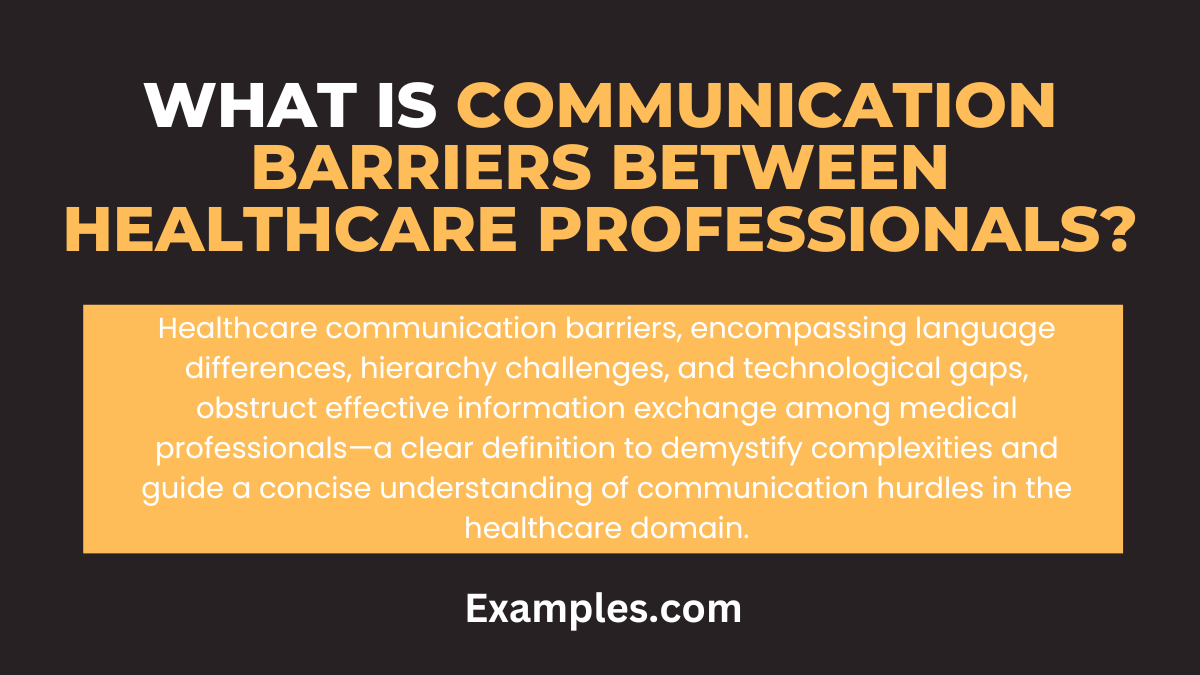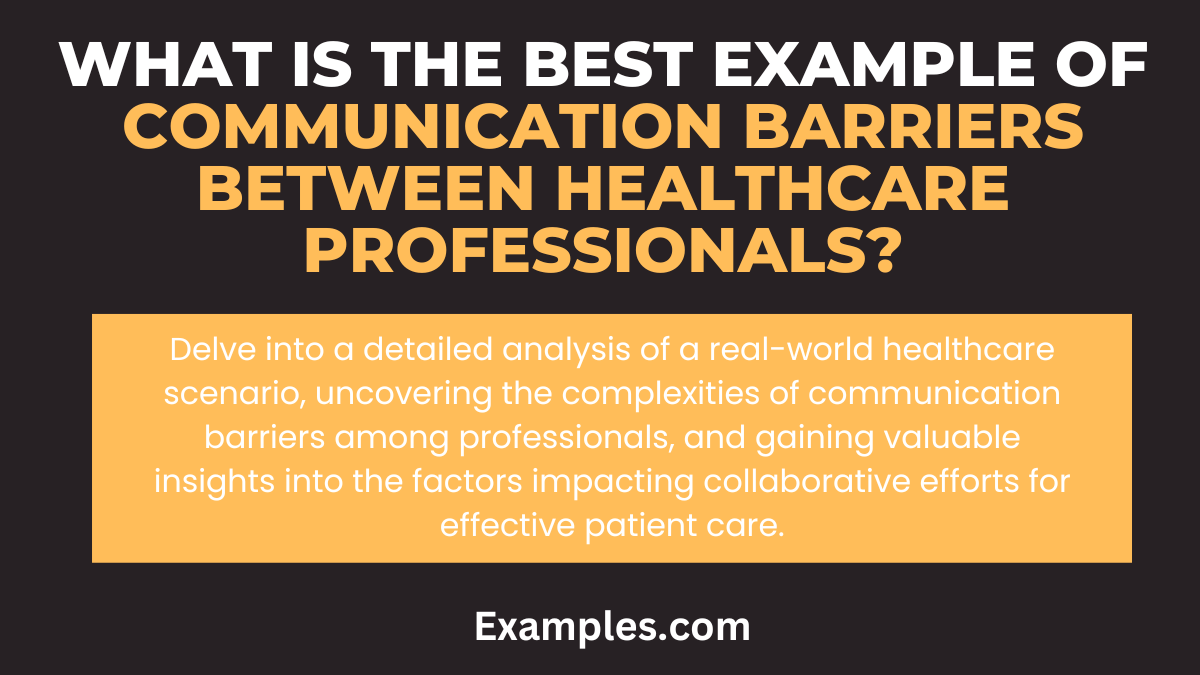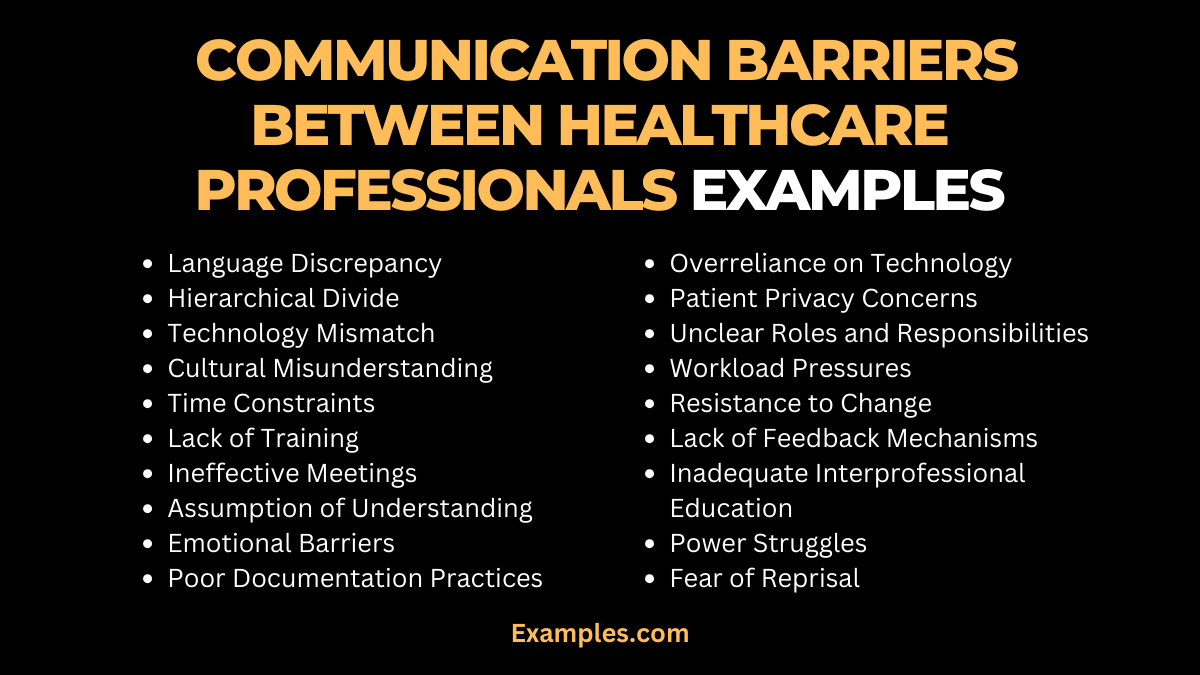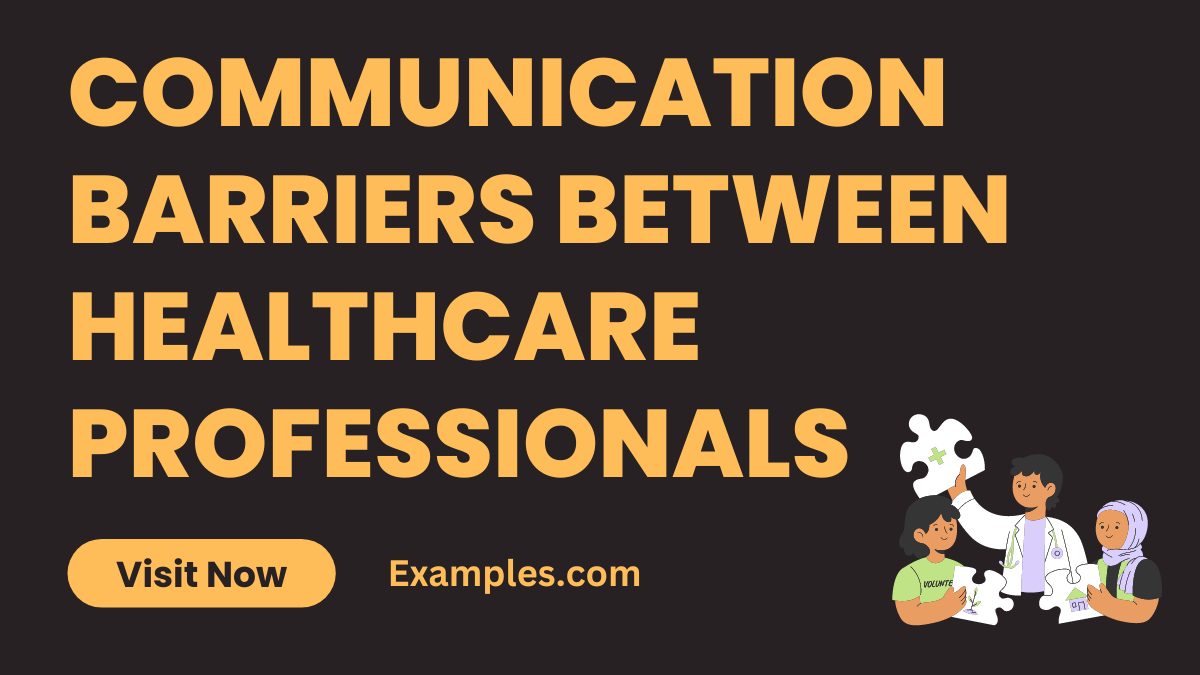19+ Communication Barriers Between Healthcare Professionals Examples
Embark on a comprehensive exploration of “Communication Barriers Between Healthcare Professionals” in this in-depth guide. Uncover the intricacies that hinder effective communication in medical settings and discover practical solutions. This article illuminates the subject with real-world scenarios and actionable examples, providing invaluable insights into overcoming obstacles. Elevate your understanding and communication prowess, as we delve into the realm of healthcare interactions, shedding light on common pitfalls and offering strategic approaches. Welcome to a holistic journey that includes “Communication Examples” to enrich your professional toolkit.
What is Communication Barriers Between Healthcare Professionals?

Communication barriers in healthcare refer to obstacles that impede effective information exchange among medical professionals. In simple terms, these hindrances can include language differences, hierarchical challenges, or technological gaps that disrupt seamless communication. This H2 heading aims to provide a clear and straightforward definition, demystifying the complexities surrounding communication hurdles in the healthcare domain. Explore this insightful guide for a concise yet comprehensive understanding of the term.
What is the Best Example of Communication Barriers Between Healthcare Professionals?

In this section, we dissect a noteworthy example that vividly highlights communication barriers within the healthcare sector. Explore a detailed examination of a real-world scenario, unraveling the complexities and nuances that contribute to challenges in effective communication among healthcare professionals. By delving into this in-depth analysis, you’ll gain valuable insights into the specific factors and dynamics at play, fostering a deeper understanding of how such barriers manifest and impact collaborative healthcare efforts.
20 Communication Barriers Between Healthcare Professionals Examples

Unlock insights into common hurdles that healthcare professionals face in effective communication. Each example is carefully crafted to illuminate specific challenges, offering practical solutions for seamless collaboration.
- Language Discrepancy:
- Example: In critical situations, using complex medical terms led to confusion among team members, impacting timely decision-making.
- Hierarchical Divide:
- Example: A nurse hesitated to report an issue to a superior, fearing repercussions, resulting in delayed patient care.
- Technology Mismatch:
- Example: Divergent electronic health record systems led to fragmented patient information, affecting collaborative decision-making.
- Cultural Misunderstanding:
- Example: Varied cultural backgrounds contributed to misunderstandings in patient preferences and treatment plans.
- Time Constraints:
- Example: In a busy ER, brief handovers resulted in oversight, impacting the continuity of patient care.
- Lack of Training:
- Example: Inadequate communication training hindered professionals from effectively conveying critical information during emergencies.
- Ineffective Meetings:
- Example: Poorly structured meetings resulted in incomplete information exchange, affecting coordinated patient care strategies.
- Assumption of Understanding:
- Example: Assuming shared knowledge led to misinterpretations, impacting the accuracy of treatment plans.
- Emotional Barriers:
- Example: Unaddressed emotional stress among team members hindered open communication, impacting the overall work atmosphere.
- Poor Documentation Practices:
- Example: Incomplete patient records resulted in misunderstandings, affecting the continuity of care during staff transitions.
- Overreliance on Technology:
- Example: Relying solely on digital communication led to misinterpretations, emphasizing the importance of face-to-face discussions.
- Patient Privacy Concerns:
- Example: Fear of breaching patient privacy limited information sharing, affecting the holistic view of patient care.
- Unclear Roles and Responsibilities:
- Example: Ambiguity in job roles led to confusion, impacting the delegation of tasks and responsibilities within the healthcare team.
- Workload Pressures:
- Example: High workloads resulted in rushed communication, leading to misunderstandings and errors in patient care.
- Resistance to Change:
- Example: Resistance to adopting new communication tools hindered efficient information exchange, affecting collaboration.
- Lack of Feedback Mechanisms:
- Example: Absence of feedback channels limited improvements, hindering the evolution of effective communication strategies.
- Inadequate Interprofessional Education:
- Example: Limited knowledge of other professionals’ roles resulted in miscommunication, emphasizing the need for interdisciplinary education.
- Power Struggles:
- Example: Internal power struggles hindered open discussions, impacting the implementation of effective patient care plans.
- Fear of Reprisal:
- Example: Fear of reprisal discouraged reporting errors, affecting the overall quality of patient care.
- Lack of Team Building:
- Example: Insufficient team-building activities resulted in weak interpersonal connections, impacting trust and collaboration among healthcare professionals.
Explore these scenarios to enhance your awareness and foster improved communication within healthcare teams.
Communication Barriers Between Healthcare Professionals for patients Examples
Unlock a deeper understanding of communication challenges that impact patient care. Navigate through real-life examples, each offering insights and solutions for effective healthcare communication.
Navigating through complex medical information is challenging for patients, and healthcare professionals must bridge communication gaps for optimal care. Let’s delve into scenarios that illuminate the barriers faced in this crucial aspect of healthcare.
1. Fear of Medical Jargon:
- Example: Boldly explain treatment plans to patients, avoiding complex medical terms to ensure clear understanding and alleviate anxiety.
2. Limited Health Literacy:
- Example: Utilize visual aids and plain language to convey information, addressing potential comprehension issues and fostering informed decision-making.
3. Uneven Access to Information:
- Example: Establish a user-friendly patient portal to ensure consistent access to medical records, fostering transparency and engagement.
4. Cultural Sensitivity Lapses:
- Example: Prioritize cultural competence to avoid misunderstandings and enhance patient trust in healthcare interactions.
5. Emotional Communication Breakdown:
- Example: Encourage open dialogue about emotions to address psychological aspects, promoting holistic patient-centered care.
Communication Barriers Between Healthcare Professionals for Nurses
Effective communication within the healthcare team is vital for delivering quality patient care. Explore scenarios that illuminate communication challenges specifically faced by nurses, along with actionable solutions.
Nurses play a crucial role in patient care, and effective communication is paramount to their success. Let’s unravel communication barriers unique to nursing professionals and explore ways to overcome them.
1. Hierarchy-Induced Silence:
- Example: Promote open forums for idea sharing, empowering nurses to voice concerns and contribute to collaborative decision-making.
2. Lack of Time Management:
- Example: Implement efficient communication tools to streamline information exchange, ensuring timely updates without compromising patient care.
3. Limited Interdisciplinary Collaboration:
- Example: Initiate regular interdisciplinary meetings to enhance collaboration, fostering a cohesive healthcare team for improved patient outcomes.
4. Inadequate Training on New Technologies:
- Example: Offer comprehensive training programs for nurses to adapt to new technologies, promoting confident use and reducing communication barriers.
5. Emotional Burnout Impact:
- Example: Establish peer support networks to address emotional challenges, ensuring nurses feel supported and fostering a positive work environment.
How do communication barriers affect healthcare professionals?
Navigating the intricate landscape of healthcare, communication barriers wield a profound impact on professionals, influencing collaboration, patient care, and overall well-being. Let’s dissect the ways these barriers affect healthcare professionals, shedding light on the challenges they encounter.
Introduction
Communication is the lifeblood of healthcare, and any impediments can create ripples of consequences. Explore the nuanced effects of communication barriers on healthcare professionals:
- Impaired Information Flow:
- Miscommunication hinders the smooth exchange of critical information, leading to delays, misunderstandings, and compromised decision-making.
- Strained Interdisciplinary Collaboration:
- Effective healthcare demands collaborative efforts from diverse professionals. Communication barriers hinder this collaboration, impacting comprehensive patient care.
- Heightened Risk of Medical Errors:
- Misunderstandings and misinterpretations elevate the risk of medical errors, jeopardizing patient safety and outcomes.
- Increased Stress and Burnout:
- Navigating constant communication challenges contributes to heightened stress, leading to emotional exhaustion and burnout among healthcare professionals.
- Impact on Professional Relationships:
- Communication barriers strain relationships among healthcare professionals, fostering an environment of mistrust and hindering cohesive teamwork.
- Delayed Diagnosis and Treatment:
- Ineffective communication contributes to delays in diagnosis and treatment initiation, impacting patient outcomes, especially in critical situations.
- Compromised Continuity of Care:
- Fragmented communication results in compromised continuity of care during transitions between healthcare professionals, affecting the overall patient journey.
Unpack the intricacies of these challenges to understand how addressing communication barriers is pivotal for fostering a resilient and effective healthcare ecosystem.
What can healthcare professionals do to reduce communication barriers?
Navigating the complexities of healthcare demands effective communication, yet barriers often impede seamless interaction among professionals. Explore actionable strategies empowering healthcare professionals to proactively reduce communication barriers, fostering a collaborative and patient-centered environment.
Cultivate a Culture of Openness
- Encourage Regular Team Meetings:
- Foster open communication by scheduling regular team meetings, providing a platform for professionals to share insights and address concerns.
- Implement Transparent Communication Policies:
- Develop clear communication policies that emphasize transparency, ensuring everyone is aware of expectations and guidelines.
Enhance Communication Training Programs
- Invest in Continuous Training:
- Prioritize ongoing communication training programs to equip healthcare professionals with the skills necessary to navigate diverse communication scenarios.
- Include Interdisciplinary Training:
- Incorporate interdisciplinary training sessions to enhance collaboration, offering insights into the unique communication styles of various healthcare roles.
Leverage Technology Effectively
- Adopt Unified Communication Platforms:
- Implement unified communication platforms to streamline information exchange, reducing the risk of misunderstandings caused by technological disparities.
- Encourage the Use of Secure Messaging Systems:
- Introduce secure messaging systems to facilitate quick and secure communication, especially in time-sensitive situations.
Promote Interpersonal Relationship Building
- Initiate Team-Building Activities:
- Cultivate a sense of camaraderie by organizing team-building activities, fostering positive relationships and improving overall communication dynamics.
- Establish Mentorship Programs:
- Facilitate mentorship programs to promote interpersonal connections, allowing professionals to learn from each other and address communication challenges.
In conclusion, this comprehensive guide delves into the intricate landscape of communication barriers among healthcare professionals. By exploring real-life examples and offering actionable solutions, it illuminates the challenges faced and empowers professionals to foster collaborative, patient-centered care. Navigate the complexities of effective communication with insights that enhance teamwork, reduce errors, and ultimately contribute to an elevated standard of healthcare delivery.



